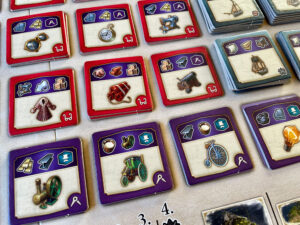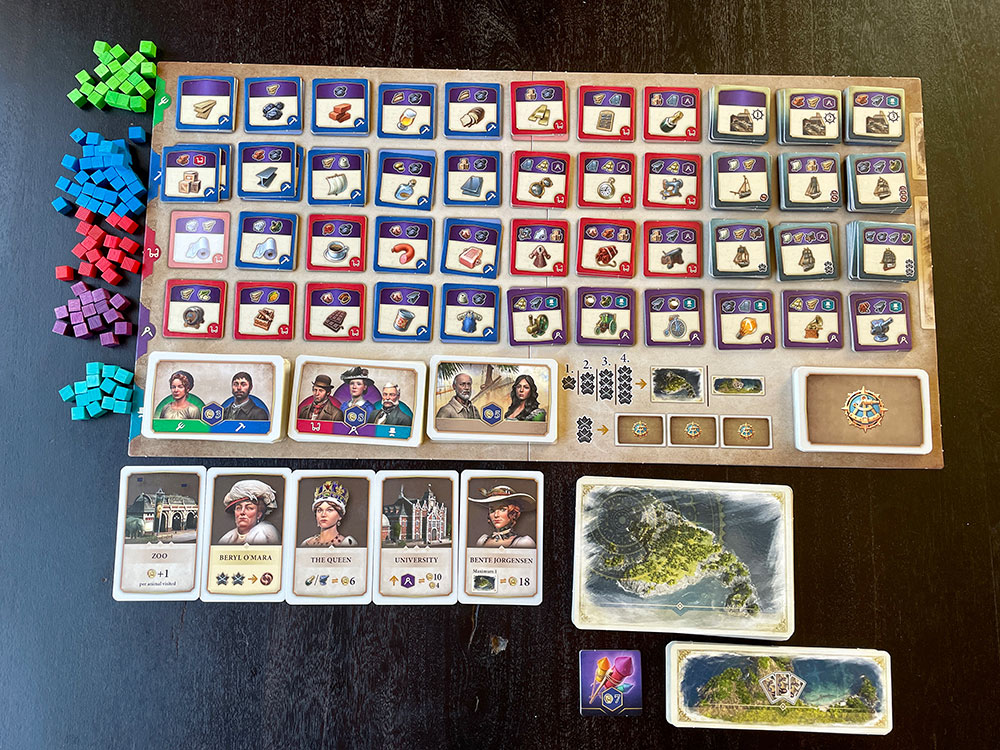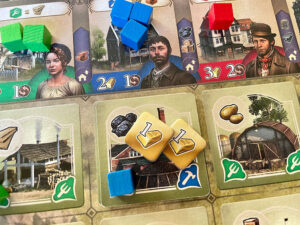 In the year 1800, things are really going to be different. There will be plenty of opportunities to expand our small island nation, build the industry our population desires, even explore worlds both old and new. What an exciting time to be alive! Should we consider celebrating all of this with a festival? Sure, sure, after we’ve plied ourselves to the brink of exhaustion. This land is ripe for a new beginning, filled with rigorous hard work and recognition. And perhaps a little beer or schnapps during a break.
In the year 1800, things are really going to be different. There will be plenty of opportunities to expand our small island nation, build the industry our population desires, even explore worlds both old and new. What an exciting time to be alive! Should we consider celebrating all of this with a festival? Sure, sure, after we’ve plied ourselves to the brink of exhaustion. This land is ripe for a new beginning, filled with rigorous hard work and recognition. And perhaps a little beer or schnapps during a break.
Designer Martin Wallace returns to European industrialization in Anno 1800, a reimplementation of a popular civ building PC game. It plays two to four players with game time between one to two hours, for ages twelve and up. Let’s set our sights on the future of our industry and get our hands dirty. It’s time to trade some goods.
Gameplay Overview:
Every player starts with a personal island board, a set of nine population cubes, and a deck of nine population cards that correspond to the needs of the island’s people. Each population cube is a specialized resident of which there are five types: farmers, workers, artisans, engineers, and investors. This workforce can assist in producing the various goods available on the main gameboard.
Each turn a player has access to one possible action from a total of nine choices. These choices include expanding into industries available on the mainboard, playing population cards, increasing/upgrading population cubes, exploring either the old or new world, or even refreshing the workforce by celebrating a festival. After a choice is taken, play continues clockwise. Game end is triggered when a player fulfills their final population card.

Much of the game is focused on industry expansion. Players utilize their workforce to produce goods that add new construction tokens to their island board. Sending a farmer to produce pigs, while sending an artisan to produce coal, is an easy way to add a sausage factory to your island. A player may want this industry to fulfill the resource need on one of their population cards. Expanding can happen immediately based on the starting workforce loadout and there are plenty of pathways to fulfill population needs as well as expand into even greater industry.
When a player needs to produce an item that cannot be added to their personal board, they have access to trade tokens via their shipping network that can be exhausted to access other players resources. By utilizing another’s resources, opponents gain gold from the supply, which can be used to refresh individual cubes on their turn.

Players also start with an exploration token via their shipping network. They can use these to explore the old world, which adds a new section of island to their player board. They can also explore the new world and gain access to unique resources that can only be utilized by that player. Both the exploration and trading tokens can be increased by adding more ships to the water spaces on the bottom of the island board.
Beyond industry, the population cards (as well as end game objective cards) provide direction via their cost. If three cards from your workforce require beer to be fulfilled, it’s important to work toward adding that industry to your island board. As cards are played, they provide bonuses such as free population upgrades, one-time use trading tokens, or additional workforce. Any new population that is added to a player’s supply also comes with a new population card from the main board draw deck.
Once any player has fulfilled all their population cards, the game ends after the current round plus one additional full round are completed. Points come from completed population cards, expedition cards (gained by exploring the new world), leftover gold, and objective cards. The player who empties their hand first also receives a seven-point fireworks token to add to their final score. The player with the most points is the winner.

Game Experience:
Anno 1800 has a lot of great ideas at play, but before I get to those, I want to discuss some of the shortcomings I had during play. Not to bury the lede, I do think those who enjoy strategic euro-style games will find a lot to enjoy here. But it’s not without its faults.
The largest issue I have with the game is the luck of the draw from the population decks, coupled with some balance issues present on both cards and exploration boards. Draw luck is directly related to balance issues as there are certainly better cards to be had, including those that give players access to their first engineer. There can be games where players must pivot from not finding these cards in their hand and it can set them back. The old-world board benefits also can be swingy at certain stages of the game, as can the randomization of the new world resource distribution.

Anno 1800 tries to negate balance issues by providing options. You can spend a turn returning and redrawing up to three population cards that don’t match your current strategy, but a lost turn can be detrimental to keeping up with efficient opponents. Don’t have the new world resources you need? Explore again and waste another turn. None of this is game breaking, but it can certainly add frustration when one player at the table is getting all the right cards and benefits while others struggle.
Beyond this, I do find the theme to be a little tired, even if it is directly based on a PC game and is trying its best to be faithful to this. Regardless of the spin on trying to keep your population happy by meeting their needs, this is a primarily white European nation expanding into new worlds where only then does diversity start to creep into the cards. As a fictional historical exercise, it doesn’t take much to inject diversity from the outset and shift the narrative away from potential comparisons in this realm. Even the exploration tokens feature crossed swords rather than a spyglass or compass, another hint at expansion at a cost.

Final quibbles include the cumbersome setup and tear down with so many individual industry tokens on the main board. Component quality isn’t the greatest, including thin cards and player aids. The expedition card inclusion also feels tacked on to increase end game scoring opportunities. And player scaling has not been given consideration and makes the two-player experience a little lackluster in comparison to three or four.
With that out of the way, now on to the good. The highlight here is the trading mechanism. In a higher player count game, players are unable to build everything, as some industries may be taken before they can get to it. As such, if players have trade tokens available, they can freely trade for resources that others produce. There is no way to deny trade and the opponent receives gold from the supply for their generosity. This creates a unique economy where options become available without significant investment, though trade tokens are in short supply and must be used wisely. It also keeps players engaged by constantly watching what others are adding to their island.
And while there’s a lot to take in at first, especially with the main board and its array of options, it doesn’t take long before the layout begins to make sense and turns start to breeze by. This is important to note because Anno 1800 may feel like a slog in the beginning, especially as players add more population and in turn more cards enter their hand. It can seem like you’re going in the opposite direction for the first half of a game before industries and resources start to click into place and cards find a way to be played in successive turns.

It’s the hand size battle that keeps the tension in place. Do you add more population to allow for more efficient turns prior to celebrating a festival? More cards mean more potential points. But it also means more time before you can trigger end game. Plus, there’s the decision to upgrade workforce roles into higher specializations that in turn limit what’s available to utilize for more basic operations, such as your farmers or your workers. This decision space is key to game enjoyment and the puzzle shifts based on objectives and population needs.
The end game trigger may feel like a race at first, but there is a definite balance of trying to score cards while also keeping objective card scoring in mind. The seven-point firework token for emptying a hand is significant, but smart players may try to forego this benefit by seeking out ways to negate it via the objectives. It may take groups some time to find the right balance of shifting away from adding cards to their hand and delaying the end game. We’ve been able to get a two-player game down to an hour, though our three-player games haven’t dipped below two hours yet.
Three player is certainly the sweet spot. At two players it doesn’t highlight the trading mechanism enough, whereas four players is just too long. With three players there’s enough trading to be had without the system overstaying its welcome. This also makes the end game trigger more dynamic as you’re not battling between two people to push for the finale.
Final Thoughts:
While I’ve not played the PC version of this game, it seems that a lot of thought was put into converting a civ building experience into a unique euro strategy game. While the focus on population specialization and growth, as well as trading, gives Anno 1800 a lot of depth, it’s not without balance issues that will impact outcomes. Those who prefer less luck may want to look elsewhere, though they’d be missing out on several mechanisms that stand out. They just happen to coincide with a rather lackluster presentation coupled with a less-than-inspiring theme. Regardless, the speedy turns and the directed gameplay in Anno 1800 will be enough for many itching for that shiny new euro.
Final Score: 3.5 stars – Fun trade and industry growth pathways combined with population needs are hampered by overused theme and balance issues.
 Hits:
Hits:
• Inspired trading mechanism
• Increasing workforce adds cards to hand
• Direction provided by population needs
• Unique tech tree choices
Misses:
• Tired theme
• Card balance issues
• Setup and tear down
• Two player scaling





















